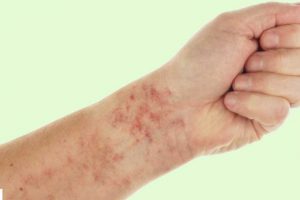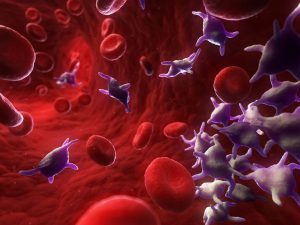Overview
Immune thrombocytopenia is a condition that is characterized by the presence of less number of blood cells called platelets or thrombocytes. Platelets or thrombocytes are found in the bone marrow. When there is a cut in the blood vessel dilators, these platelets are released and they stick together to seal the blood vessel. This is called clotting.
Due to this condition, in the event of a wound or a cut, the blood doesn’t clot properly the way it does, in a healthy person. With immune thrombocytopenia (ITP), internal bleeding may also occur from the small blood vessels, under the skin. Sometimes the bleeding may occur outside the skin too. When there is internal bleeding due to the presence of a wound, from the small blood vessels, purple color bruises are formed under the skin. This is called immune thrombocytopenia Purpura.
Additionally, people with ITP may also see the formation of pinpoint size dots on the skin, which are red or purple in color and they look like a rash. These dots are called petechiae. People with ITP are seen to have more nosebleeds and a lot of bleeding from gums during dental work. When injured accidentally by a cut in the skin, the bleeding may be difficult to stop. Women with ITP are known to experience heavier bleeding during the menstrual cycle. Immune thrombocytopenia is also called as Idiopathic thrombocytopenic or autoimmune thrombocytopenic purpura.
Causes
Immune Thrombocytopenia (ITP) is caused by an autoimmune response in the body. The immune system is responsible for fighting off infections by attacking harmful pathogens. However, in this case, the immune system mistakenly starts attacking its own platelets, this leads to a steep decrease in the number of platelets in the body.
The reaction that causes ITP may be triggered by a recent series of viral infections, especially in children. Immune Thrombocytopenia is found to be linked to viral or bacterial infections, such as HIV, hepatitis C, or H. pylori.
Symptoms

Symptoms of Immune thrombocytopenia may not be obvious. It causes bleeding inside the body or under the skin or outside the skin, and the signs include:
- Bleeding under the skin causes purplish areas under the skin called purpura. Purpura can be sometimes seen in the mucous membranes like the inside of the mouth.
- Bleeding under the skin also causes a group of pinpoint-sized red or purple dots called petechiae. They occur in a pattern and resemble a rash on the skin.
- Lumps may be found under the skin, which is the result of residual clotted or partially clotted blood called hematoma.
- Traces of blood may be found in urine or feces.
- Bleeding from the gums during dental work
- Frequent nosebleeds
- Contact Dermatitis
- Heavy menstrual bleeding in women
- Rarely there can be bleeding in the brain which can be critical but the symptoms may vary.
- Any kind of bleeding that gets difficult to stop and takes a long time to clot.
- ITP may not show pain symptoms but excessive fatigue may be experienced by the patient.
- ITP can be seen in both children and adults. Children may develop acute ITP after a viral infection and the condition may be short-term and goes away later. However, ITP in adults is chronic and lasts longer.
- Women are two to three times likely to get chronic ITP than men.
- ITP is now easily detected by routine blood tests during screenings.
- ITP cannot be contracted from one person to another.
Diagnosis
The diagnosis of ITP is done by the following steps. Your doctor may first look at your medical history, followed by a physical exam. The doctor may also do some tests based on his findings and to rule out other causes of low platelet count like an infection or side effects of medicines you take (chemotherapy medicines or aspirin)
Medical History
At your first doctor’s visit, your doctor may inquire about the following:
- Any symptoms of bleeding or other unrelated symptoms you have.
- Any illness that could be the cause of low platelets count.
- Any medicines or supplements you are taking that could cause low platelet count and signs of bleeding.
Physical Exam
Your doctor may perform a physical examination to help identify Immune Thrombocytopenia. The doctor will look for any signs and symptoms associated with ITP such as:
- Areas on the skin that are purple in color
- Purple areas on the mucous membranes such as mouth
- Pinpoint red dots on the skin called purpura, which is an obvious sign of bleeding under the skin and ITP.
Diagnostic Tests

The doctor may order specific blood tests that check your platelet count, which include:
- Total count of blood cells: The tests check the count of all the blood cells, like red blood cells, white blood cells, and platelets. ITP is identified if the red blood cells and white blood cells are normal but the platelets are found very less in number.
- Blood smear: The doctor may take a small sample of your blood and test it under a microscope to take a closer look at your platelets and other blood cells.
- Tests for checking Antibodies: You may also have a blood test to check the number of antibodies in your blood. Antibodies are the proteins that are known to be the cause of low platelet count in ITP as they attack the platelets due to an autoimmune response.
- Bone marrow test: If you are diagnosed with ITP, your doctor may add another test to check if your bone marrow is making enough platelets.
- Tests to rule out infections: HIV, hepatitis C, or Helicobacter pylori are known to be linked to ITP. Your doctor may order screening for these infections, to know the cause of ITP.
Sometimes mild cases of ITP are discovered, during a routine blood screening. Mild cases of ITP show no signs of bleeding; hence when a blood test is done for another reason, low platelet count is diagnosed.
Treatment

Treatment options for ITP may vary depending on the extent and frequency of bleeding. The level of your platelets is also considered while deciding on the treatment.
- No treatment may be necessary for adults whose platelet count is not so poor, it is considered as mild ITP. However, they are regularly screened to watch and track their platelet count.
- Adults who report of bleeding problems or have very low platelet count are considered for treatment
- In children, acute ITP that develops after a series of viral infections goes away within a few months and hence usually needs no treatment.
- However, children who report of bleeding problems apart from symptoms of purpura are treated.
- Some kids have mild ITP, so they only need constant monitoring and screening to make sure their platelet count returns to normal.
Medications
The first step towards the treatment involves the administration of medicine. Both children and adults are treated alike by trying to increase the platelet count by giving medicines.
- One of the most common medicines for the treatment of ITP is Corticosteroids.
- Corticosteroids help increase your platelet count and do not cause addiction. They are not habit forming, and hence can be easily taken for a long time.
- However, Corticosteroids do have some side effects
- Some medicines that increase the platelet count can be administered intravenously. They include drugs in the class of immunoglobulins.
- A procedure called Splenectomy may also be performed along with the administration of medicines. This procedure is aimed at the removal of the spleen.
Splenectomy (Removal of the spleen)

When the medicines do not help treat ITP, a procedure called Splenectomy is performed. This surgery is aimed at the removal of the spleen.
The spleen is an organ that is located at the upper left abdomen. It does the size of a golf ball in children and as big as a baseball in adults.
The spleen is responsible for the production of antibodies that fight the infections. However, in ITP the same antibodies are responsible for attacking the platelets and destroying them. Hence, the removal of the spleen will help stop the antibodies from attacking the platelets.
Your doctor will discuss the risks involved after the removal of the spleen. After the surgery, there is a higher risk of contracting infections and your doctor may administer you with some vaccines to ward off the infections. Your doctor will ask you to follow strict instructions to avoid any infections and to keep a watchful eye on any symptoms you might develop.
Other Treatments
Platelet transfusion: When patients with ITP experience severe bleeding, platelet transfusion has to be done to restore normalcy. In some cases, some patients may require platelet transfusion before undergoing surgery. Platelet transfusion is done by injecting the patient with donor platelets that are stored in the blood bank. This helps in increasing the number of platelets for a short time.
Treating infections: It is a known fact that certain viral infections can lower your platelet count. Treating those infections will restore the platelet count back to normal and reduce bleeding problems.
Discontinuing certain medicines: Your doctor may ask you to discontinue medicines that lower your platelet count. Avoiding these medicines will also help to reduce the risk of bleeding if you have ITP.
Prevention
Since Immune Thrombocytopenia is an autoimmune disease, it cannot be prevented.
However, it is possible to prevent complications that may arise due to ITP.
- Avoid medicines that affect the platelets and increase the risk of bleeding. Such medicines may not safe for you. Common examples are Ibuprofen and aspirin
- In case you develop an infection, report it to the doctor immediately. For patients with ITP who have their Splenectomy, it is critical to visit the doctor at the first sign of infection.
- Though sometimes injuries cannot be avoided, it is possible to avoid such situations, where you may be susceptible to an injury. Stay away from anything that can cause bleeding or bruising.
- Complications can be prevented in patients suffering from ITP if you also allow some lifestyle changes and include some ongoing care an essential part of your life.
Lifestyle Changes
- Avoid participating in contact sports such as boxing, football, karate which can cause head injuries and bleeding in the brain.
- Horseback riding, skiing, are some other sports that are not safe for you if you have ITP.
- There are some activities that you can still enjoy, which are considered safe for people with ITP. They include swimming, biking with your helmet on, and walking.
- Ask your doctor about physical activities that are safe for you. It is best to have a discussion with your doctor before you take up any activity.
- Other basic precautions include wearing a seatbelt while driving and using kitchen gloves while cooking and cleaning especially while handling sharp objects like knives and cutters. These precautions are for everyone but if you have ITP, you can never skip these instructions.
- If your kid suffers from ITP, make sure you ask his doctor what activities are safe for the child and what are not.
Ongoing Care
It is important to receive regular ongoing care if you have ITP. Make sure you a find a doctor who has experience with treating blood disorders. They are called hematologists. They can help you manage the ITP and provide the right medical care.
- Ask your doctor before popping any over the counter pills, even for a cold, or medicines for pain relief, or herbal remedies or supplements, as they may prove to be harmful to you.
- Some medicines like aspirin and ibuprofen can lower your platelets and increase the chances of bleeding. Your doctor may ask you to avoid such Medicines.
- Be alert for any signs of infections and report it to the doctor immediately, especially if you had your spleen removed. Splenectomy may increase your chances of getting sick from certain infections.
Immune Thrombocytopenia in Pregnancy

- If the mother has ITP, the baby will not be affected by the condition, during delivery. In some cases, the babies were found to have low platelets soon after birth.
- The low platelets in just born babies tend to restore back to normal after some time, usually without any treatment. However, with treatment, the process of recovery is faster.
- The treatment options for pregnant women suffering from ITP depends on how low the platelet count is. Pregnant women with mild ITP can go with delivery without getting treatment.
- If the platelet count is too low, during pregnancy, the doctor may suspect heavy bleeding during the medical abortion or afterward which may be critical for the mother. In such a case, the doctor will consider the best options for treatment that doesn’t affect the unborn baby.


















